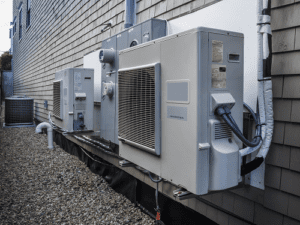Whether you are scoping out commercial air conditioning units for a new building or in the market to replace a broken or outdated AC unit, you are likely concerned with commercial AC unit cost. HVAC equipment can be expensive to purchase, and the expenses don’t end with the upfront investment either. On the contrary, which AC unit you choose for your building can affect a range of factors going forward—from energy efficiency and utility bills to the costs of ongoing maintenance. For these reasons, it’s important to consider a commercial AC unit purchase from multiple angles before you buy, to try getting a sense for how expensive the unit will be both now and in the long run. In this blog post, we will try to shed some light on how you might go about calculating the cost of a commercial air conditioning system.
The Factors That Affect Commercial AC Unit Cost
 The first thing to understand about the cost of a commercial air conditioning unit is that it can run quite a range. An AC unit for a small one-story office is going to cost much less than an AC unit for a large 10-story office building. Numerous factors can influence how much you spend on a new AC unit. Here are a few of the factors to keep in mind as you shop for a new system:
The first thing to understand about the cost of a commercial air conditioning unit is that it can run quite a range. An AC unit for a small one-story office is going to cost much less than an AC unit for a large 10-story office building. Numerous factors can influence how much you spend on a new AC unit. Here are a few of the factors to keep in mind as you shop for a new system:
- The size of your commercial building:
As we already mentioned, building size is a major factor when determining commercial AC unit cost—or the cost of any HVAC system, for that matter. Sizing your AC unit to suit your building is one of the most important steps of purchasing a new unit. An underpowered air conditioning unit will struggle to meet your cooling needs, while an overpowered system will over-cool certain areas and under-cool others, leading to temperature inconsistencies throughout your building (among other problems). Every air conditioning unit has a specified capacity, measured in British Thermal Units (BTUs). A unit with more BTUs is more powerful and better suited to a larger building, while a system with a more modest BTU count is a better fit for a smaller space.
In general, for a commercial building with standard eight-foot ceilings, you can estimate cooling load by taking the building’s square footage, dividing by 500, and then multiplying that figure by 12,000. This equation will give you a ballpark number of BTUs that your AC unit will need to be able to move. So, for an office building that is 2,000 square feet, the estimated cooling load would be 48,000 BTUs.
Calculating BTUs in this fashion is probably the quickest way to estimate the cost of a commercial AC unit because you will be able to research the cost of units that match your estimated BTU load. However, before you buy anything, it’s still a good idea to consult an HVAC contractor to get a professional opinion on how big your AC unit should be. There may be other factors—such as the height of your ceilings or the overall layout of your building—that affect the cooling load of the building.
- The type of unit
There isn’t just one type of AC unit. On the contrary, commercial cooling can be carried out by a range of different systems. Central air is the go-to option for most commercial buildings, as it is efficient, cost-effective, and well-suited to larger buildings. However, depending on your structure and your specific cooling needs, you might be drawn to something else, such as a ductless mini-splits, heat pumps, and evaporative air conditioners. Each type of unit has its pros and cons that you will need to consider. For instance, a ductless mini-split doesn’t require ductwork, which means it is cheaper and easier to install than a full central air system. However, ductless mini-splits struggle with cooling wide-open spaces and are typically not sufficient for larger buildings. Of course, if your building already has ductwork, you don’t need to worry about that installation cost. Even if you have ducts, though, you might want to think about cleaning, insulating, and sealing them before installing a new AC unit.
Talk to your HVAC contractor to get a professional recommendation on which type of unit is right for your building.
- Other features
As with any equipment, different types of air conditioning units come with various features or perks. For instance, certain brands are known for their high-efficiency ratings, known as SEER ratings (“SEER” stands for “seasonal energy efficiency ratio”). You will pay more for higher SEER ratings but will likely make that money back over time because you are paying less to run your system. On another note, if your building is large, you will probably need a “zoned” cooling system, which will add expense. Finally, consider the reputation of different AC brands. You want a trusted brand that makes units known for their efficiency, capable performance, and longevity. Remember: upfront cost isn’t everything. It’s worth paying more for a quality system and installation—if it means you’ll spend less on utility bills and maintenance going forward.
Consult with Your HVAC Contractor Today
Accurately calculating commercial AC unit cost is difficult, given the number of different variables at play. Fortunately, any reputed HVAC contractor will be happy to chat with you about your project, survey your building, give you a few recommendations, and quote you a price that includes the cost of the unit and the labor involved in the installation. Contact a trusted HVAC contractor today for this type of helpful consultation.

